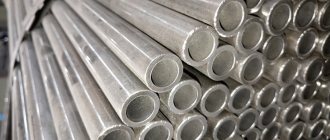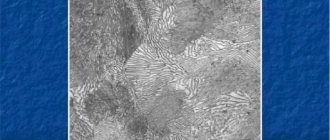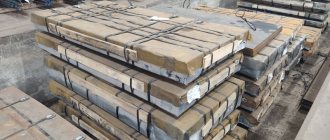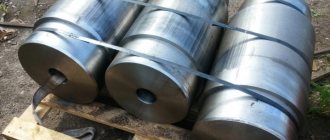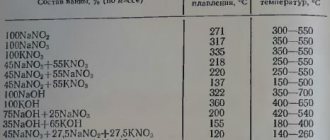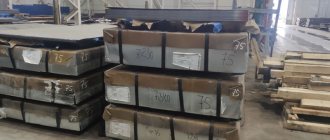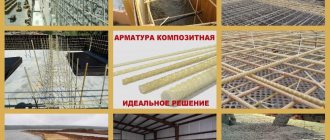The alloy, which is characterized by ease of use, ease of processing, good strength and hardness, as well as low cost, can confidently be called universal, applicable in any conditions. Steel 20 is not a specialized steel; on the contrary, its application possibilities are so wide that it has found a place in almost every industrial sector.
Detailed information on the supply of sheet steel and a price calculator can be found on our website.
Total information
Steel 20 is a structural carbon quality steel widely used in industry. Its popularity is not inferior to 09G2S steel, although in terms of technical and operational characteristics there is a noticeable difference between these grades. Steel 20 is used mainly for the production of parts, welded structures, in construction, and mechanical engineering, but a complete list of industries for its use would take several pages of text. The practicality of steel of this grade allows it to occupy one of the leading positions on the market among ferrous rolled metals.
Welding carbon and alloy steels: equipment and materials
Steel products create modern civilization. Synthetics have partially replaced metal from some niches (for example, engineered heating and plumbing systems), but against the backdrop of the overall volume of use this has passed almost unnoticed.
But where there is steel, you need to connect parts made from it. Therefore, steel welding has long been identified as a separate branch of industry and science.
Moreover, it turned out that even metals, the parts of which did not have noticeable differences in appearance, have different attitudes towards creating a connection.
This is influenced by the added additives, called alloying agents, as well as the carbon content.
Effect of doped impurities
Alloying impurities are impurities that change the properties of iron . In fact, only they turn it into familiar material. Such additives are rare earth metals (eg molybdenum, nickel, vanadium), halogens (sulfur, phosphorus), elements such as silicon or manganese. The most common is carbon.
The influence of impurities depends on their percentage composition relative to volume. This is especially noticeable in the example of carbon additives. Welding high carbon steels is more difficult than most high alloy grades.
Among other things, some additives burn out at high temperatures. This leads to a change in the properties of the metal at the junction. As a rule, for the worse.
Source
Characteristics
The metal is characterized by excellent weldability; there are no special requirements for welding, except in cases where the parts have previously been subjected to chemical or heat treatment. Steel 20 is not prone to temper brittleness and is insensitive to flakes and flake sensitivity. The alloy is resistant to pressure treatment, can be cut well by any means, does not crack, and is amenable to surface machining.
Steel 20 is less resistant to chemical attack; contact with alkalis and acids is not recommended. There is no protection against corrosion; products made from steel 20 are not recommended for use in conditions of high humidity, in contact with water without additional protective coatings (zinc, chrome or paint).
Advantages and disadvantages of steel 20
Steel 20 is distinguished by its quality and relatively low production cost. It is an upgradeable alloy, making it adaptable to a wide range of conditions and, as a result, widespread.
Steel 20 is corrosion-resistant and susceptible to chemical influences - this is its main drawback. The advantages include:
- good weldability without special requirements for the procedure;
- disinclination to temper fragility;
- insensitivity to flakes;
- price-quality ratio;
- material density;
- moderate strength.
Steel 20 is a ferrous metal with a simple composition without expensive alloying additives. The alloy has been produced for a long time, the production process is well studied, optimized, and worked out; There are no special conditions or requirements, so the metal is not very expensive.
Description, symbol
- Category – high quality structural
- Group according to the presence of alloying elements – chrome vanadium
- Corrosion resistance group – I (completely resistant)
- Strength class – K52
- Carbon content by mass, % – 0.13
The symbol must contain:
The symbol may include other data - length, manufacturing accuracy, strength class, quality group.
Example of designation with explanation
Pipe 299x8.0 13HFA TU 14-3R-124-2017
Pipe
with an outer diameter of 299 mm, wall 8.0 mm, steel 13HFA, manufactured according to TU 14-3R-124-2017.
Explanation of markings
The marking of steel 20 indicates the chemical composition of the alloy, in particular; on the proportion of carbon in the composition. Since 20 steel is considered high quality, higher demands are placed on the accuracy of its chemical composition.
Chemical composition
The chemical composition of steel 20 includes the following elements and their designations:
- Carbon. The first digit 20 indicates the carbon content in hundredths, i.e. 0.2%. The advantage of steel with a high carbon content is higher strength, but this same indicator leads to a decrease in ductility.
- Silicon. The proportion of silicon in the alloy ranges from 0.17 to 0.35%. Due to the presence of silicon in the metal composition, porosity and the number of gas pockets, which negatively affect the strength of the alloy, are reduced. Pores and cavities are formed due to oxygen, nitrogen and hydrogen gases, the particles of which are removed by silicon.
- Manganese. The proportion of manganese ranges from 0.35 to 0.6%. Manganese, like silicon, prevents oxidation and also removes sulfur from the composition. Thanks to manganese, heat treatment under pressure occurs with a low probability of crack formation, the effectiveness of forging and welding works improves, and the surface of products becomes of higher quality.
- Chrome, copper, nickel. The proportion of nickel and copper usually does not exceed 0.3%, the proportion of chromium; 0.2%. These are alloying additives that have a positive effect on the properties of steel, but in this case their content is insignificant, so they do not have a noticeable effect on the characteristics of the alloy.
- Phosphorus, sulfur. Phosphorus content is permissible up to 0.035%, sulfur; up to 0.04%. These are impurities that have a harmful effect on steel. They increase brittleness and negatively affect toughness, as a result of which the steel loses its resistance to dynamic loads.
- Iron. The rest of the alloy is iron.
Chemical composition in % of material 20
| C | Si | Mn | Ni | S | P | Cr | Cu | As |
| 0.17 — 0.24 | 0.17 — 0.37 | 0.35 — 0.65 | up to 0.3 | up to 0.04 | up to 0.035 | up to 0.25 | up to 0.3 | up to 0.08 |
GOST 1050-88
Processing methods and existing analogues
Grade 13HFA is quite easily subjected to basic processing methods:
- cutting with a mechanical tool;
- main types of welding;
- forging;
- conventional instrumentation.
For transverse or longitudinal cutting of manufactured products, no special tools are required. This is evidenced by the physical and mechanical properties of the alloy. The weldability of such an alloy has no restrictions. It can be forged already at temperatures above 860 °C. Studies of the produced metal have shown that it is not flake-sensitive.
The presence of the necessary alloying additives in the alloy leads to the appearance of specific, so-called hardening structures. During welding, their formation can lead to a decrease in resistance to cold and hot cracks. With severe overheating, resistance to brittle fracture decreases. This effect is caused by the formation of enlarged austenite grains.
The presence of alloying additives has a positive effect not only on anti-corrosion properties, but also on resistance to overheating. There is an increase in impact strength at the boundaries of the formed seam. The reliability of the welding site is significantly increased.
Types of rental
There are two main technologies for producing rolled profiles from steel 20:
- Hot deformation - used for rolling workpieces more than 4 mm thick. Hot deformation leads to the formation of scale, which is the main disadvantage of this technology.
- Cold deformation; used for rolling thin workpieces (up to 4 mm). As a result of cold deformation, the strength of the alloy increases due to cold hardening.
Types of steel products 20
- profile of all varieties: channel, sheet, I-beam, angle, rod, wire;
- seamless, high-strength pipes obtained by drawing (cold or hot);
- all-welded cold-rolled pipes, welded from a single sheet of steel 20 along the length of the pipe.
Production Standards
- long products, including shaped steel - GOST 1050-88, GOST 2590-2006, GOST 2591-2006, GOST 2879-2006, GOST 8509-93, GOST 8510-86, GOST 8240-97, GOST 8239-89;
- calibrated rod - GOST 7417-75, GOST 8559-75, GOST 8560-78, GOST 10702-78;
- polished rod and silver - GOST 14955-77;
- thick sheet - GOST 1577-93, GOST 19903-74;
- thin sheet - GOST 16523-97;
- tape - GOST 6009-74, GOST 10234-77, GOST 103-2006, GOST 82-70;
- wire - GOST 5663-79, GOST 17305-91;
- forgings and forged blanks - GOST 8479-70;
- pipes - GOST 10704-91, GOST 10705-80, GOST 8731-74, GOST 8732-78, GOST 8733-74, GOST 5654-76, GOST 550-75.
Steel 13HFA Moscow and Moscow region
Steel has a wide range of applications in mechanical engineering, manufacturing, construction, shipbuilding, aircraft manufacturing and many other industries. There are many grades of steel, most of them are made to order, there are grades that are constantly in stock due to regular demand. The Resurs company sells 13HFA steel directly from the manufacturer. With constant demand, we are ready to offer mutually beneficial terms for the supply of many grades of steel. Including 13HFA.
The favorable price for the 13HFA brand is determined by the minimum markup and the absence of intermediaries. We take full responsibility for the supplied material and guarantee the quality of delivery. The cost of products is determined by warehouse and logistics costs; we have the ability to supply steel directly from the manufacturer’s plant, this allows our clients to run their business stably.
Purpose and application
Steel 20 is one of the most common steel grades in the domestic industry; its versatility allows the production of almost all types of metal products. The main areas of application of steel 20:
- Mechanical engineering. Steel 20 is used to make fastening devices, connecting elements of mechanisms, gears, worms, brackets, bearing shafts, and liners.
- Pipelines. Steel 20 is used to make welded and seamless pipes, shut-off valves and adapters; crosspieces, union nuts, nipples, fittings, hexagons, couplings, taps, manifolds, superheaters, parts of boilers operating under high pressure.
- Construction. Fasteners, hooks, load-bearing trusses, beams and much more. In construction, steel 20 is popular due to its good weldability, satisfactory strength and availability.
Scope of application 13HFA
Metal grade 13HFA GOST 4543-71 is used for the production of pipes using the so-called seamless technology. Maintaining its mechanical and physical properties even after prolonged exposure to both high and low temperatures. Such pipes are produced in lengths from 4 meters to 12.5 meters. As additional products, they produce various types of pipe blanks, a wide range of fittings for connections (pipe transitions, tips, flanges, and so on).
All manufactured products are mainly used in the oil and gas industry.
Seamless oil and gas pipes 13xfa
In these industries, similar products are used:
- in transport systems for pumping oil and gas;
- in process pipelines on drilling rigs and production wells;
- is part of the equipment to maintain the required reservoir pressure, especially in areas with very low temperatures. Especially in regions with temperatures down to -60 °C;
- on mining and transport systems in areas with a hot climate, up to +40 °C;
- in transport systems, inside which transported components can warm up to 40 °C. With operating pressure inside the pipe up to 7.4 MPa.
- in pipelines within production systems to deliver crude oil from deep wells.
Domestic analogues of 13KhFA steel in accordance with established standards are 15KhFA, 20KhFA and 09SFA. It is quite difficult to find direct analogues of foreign grades that would correspond to 13HFA steel. Therefore, comparisons are made according to strength class. For 13HFA it is equal to K52.
Source
Three types of steel 20 according to deoxidation level
Deoxidation is the removal of oxygen from the composition of steel 20 in order to reduce the brittleness during hot working. The degree or level of deoxidation can also be called the degree of gas evolution during steel solidification. The intensity of gas evolution or boiling greatly affects the structure of the frozen metal; accordingly, the higher the level of deoxidation, the more solid and durable the structure will be.
Quiet and semi-quiet steel
Steel, which is deoxidized by silicon and manganese, can be maximally purified of oxygen content. Such steel is characterized by a complete structure without bubbles and pores, because the alloy solidifies in a calm state, without active release of gases. The formation of a shrinkage cavity occurs in the upper part; it is removed mechanically.
Quiet steel is more expensive than boiling and semi-quiet steel, because more difficult to produce. It is used in the manufacture of products with high strength requirements, for example, for load-bearing structures, railway tracks, etc.
Semi-quiet steel; an average state between calm and boiling steel, characterized by medium porosity. It comes in different qualities and is used for the manufacture of welded structures, blanks for rolled pipes, and fasteners.
Calm steel has the highest levels of strength and reliability, but its use may not be economically viable in industries where high demands are not placed on steel products.
Boiling steel
Steel 20, the deoxidation process of which is carried out thanks to manganese, contains the largest amount of dissolved gases and iron oxides. When boiling steel hardens, nitrogen and carbon dioxide are actively released, and multiple bubbles and pores are formed. Such steel is inferior to calm and semi-quiet steel in terms of strength, but has a number of positive characteristics. It is perfectly stamped, the process of its production is simpler and cheaper, and the production is waste-free.
Boiling steel is suitable for the production of products that are not subject to high loads during operation. This can be various types of fencing, sheet cladding, and other metal structures.
Tees GOST 17376-2001 art. 13HFA
Tees made of steel 13HFA with a design in accordance with GOST 17376-2001 are the most economical solutions for the installation of pipelines with chemically aggressive media and low ambient temperatures. The corrosion resistance of 13HFA steel allows the use of such tees at oil and gas production sites. The cold resistance of this material allows use at temperatures from minus 60 to plus 40°C with an ambient temperature from plus 5 to plus 40°C under pressure up to 7.5 MPa.
Manufacturing of tees from steel 13HFA
GOST 17380-2001 for technical conditions of seamless pipeline parts does not describe the use of 13HFA steel. However, the strength characteristics of this material make it possible to produce tees from 13HFA steel according to the geometry of GOST 17376-2001.
Semi-finished products for the manufacture of 13HFA tees can be seamless pipes in accordance with TU 1317-006.1-593377520-2003, TU 1308-226-0147016-02, TU 1317-233-0147016-02 and other technical conditions. "Energostandard Company" offers only products from well-known and responsible manufacturers that meet all the required structural, physical and chemical characteristics.
Chemical composition of steel 13HFA
The mechanical characteristics and chemical properties of 13HFA tees are determined by the composition of this material. Structural alloy steel 13HFA is used for the manufacture of hot-deformed pipes for field and main oil and gas pipelines, low-pressure field water pipelines.
The characteristics of 13HFA steel are described in detail in GOST 5640-68.
13HFA steel contains from 0.08% to 0.13% carbon, and on average 0.54% manganese, 0.28% silicon, 0.55% chromium, 0.3% nickel, harmful impurities of sulfur and phosphorus 0. 02 and 0.05% respectively. Steel 13KhFA has a ferrite-pearlite structure with cementite, predominantly round in shape; banding is determined by the general orientation of the structure in the direction of deformation without clearly defined bands.
The closest substitutes for 13KhFA steel are materials 15KhFA, 20KhFA, 09SFA.
Corrosion resistance of tees 13HFA
An advantageous property of 13HFA steel is the manifestation of high-quality properties at a low alloying level. This determines the obtainment of valuable material properties at relatively low costs for alloying elements.
Oilfield facilities are characterized by a high content of hydrogen sulfide, carbon dioxide and oxygen. GOST 17376-2001 tees made of 13HFA steel can be used in media with mineralization up to 100 mg/l.
Tees 13HFA are significantly superior in corrosion resistance to tees made from steel 09G2S. Manganese, which is part of the 09G2S material, impairs corrosion resistance, since it is more active than iron and forms oxides and sulfides. The parameters of their crystal lattices differ from those of iron oxides and sulfides. As a result, corrosion products loosen and peel off from the metal surface.
Steel 13HFA is chromium-containing. This metal forms an amorphous hydroxide, which coats the surface of the steel, binds the iron carbonate crystals together and protects them from dissolution by the medium. This is evidenced by studies conducted in oil fields of Western Siberia and the Komi Republic.
Steel 13HFA provides tees with a general corrosion rate of no more than 0.35 mm/year and resistance to sulfide cracking under mechanical stress of no less than 0.75∙σ0.2. Resistance to hydrogen cracking along the crack length (CLR) - no more than 1%, along the thickness of the cracks (CTR) - no more than 3%.
Strength of tees 13HFA GOST 17376-01
13HFA tees correspond to strength class K52 and higher, which corresponds to a tensile strength σв = 500 – 627 MPa and a yield strength σт = 334 – 470 MPa.
Steel 13HFA is almost twice as hard (HB=248 MPa) as steel 09G2S. This indicates greater resistance to erosion of 13KhFA tees compared to 09G2S tees.
Installation and operation of tees 13HFA
GOST 17376 tees made of 13HFA steel have good weldability. The low carbon content eliminates hardening and overheating during the welding process, so ductility is not reduced and grain size does not increase. Welding can be carried out without heating.
Tees made of carbon steels 20A and 20C with increased corrosion resistance and cold resistance
Seamless tees with requirements for increased corrosion resistance and cold resistance can also be made from pipes of steel 20A and 20C. Tees made of 20A steel are made from seamless oil and gas pipeline pipes of increased operational reliability. Steel 20C (20 “C” select) is used for the manufacture of hydrogen sulfide-resistant tees with increased performance characteristics.
Symbols of 13HFA tees with a design in accordance with GOST 17376
The symbol for an equal tee of the 2nd design, for example, with a diameter of 273 mm, T = 12 mm made of 13HFA steel, is written as follows:
Tee 273x12 st. 13HFA GOST 17376-01,
seamless transition tee made of steel 13HFA version 2 for parameters D=273, T=12, D1=219, T1=10:
Tee 273x12-219x10-13HFA GOST 17376-2001.
Purchase tees made of steel 13HFA in accordance with GOST 17376
"Energostandart Company" offers favorable corrosion-resistant tees of the highest quality. Buy tees made of 13HFA steel, call our numbers.
Seamless welded tees GOST 17376-2001 Design
Prices for Tees GOST 17376-2001 Art. 13HFA
Conventional diameter DN (DN) Main outer diameter x wall thickness - Branch outer diameter x wall thickness, mmPrice including VAT, rubWeight (weight), kg
Mechanical properties
Steel 20 is characterized by high mechanical properties, such as ductility, hardness and strength. The high impact strength allows the steel to adequately withstand increased dynamic loads. Strength is improved by thermal or mechanical treatments - peening, roller rolling, annealing, normalization.
The specific gravity of steel is 7.85 g/cm3. Maximum linear expansion coefficient st 20 = 14.8·10-6 deg-1 at temperatures 27-700°C. Indicators for calibrated hot-rolled steel of the 2nd category: temporary tensile strength 410 MPa, relative elongation after fracture 25%, relative contraction 55%, Brinell hardness 4.8.
Mechanical properties at T=20oC of the material 20.
| Assortment | Size | Eg. | s in | s T | d5 | y | KCU | Thermal change |
| — | mm | — | MPa | MPa | % | % | kJ/m2 | — |
| Heat treated sheet, GOST 4041-71 | 4 — 14 | 340-490 | 28 | |||||
| Hot-deformed pipes, GOST 550-75 | 431 | 255 | 22 | 50 | 780 | |||
| Pipes, GOST 8731-87 | 412 | 245 | 21 | |||||
| Pipes, GOST 10705-80 | 372 | 225 | 22 | |||||
| Rolled products, GOST 1050-88 | up to 80 | 410 | 245 | 25 | 55 | Normalization | ||
| Rolled products cold-hardened, GOST 1050-88 | 490 | 7 | 40 | |||||
| Rolled products annealed, GOST 1050-88 | 390 | 21 | 50 | |||||
| Annealed tape, GOST 2284-79 | 310-540 | 18 | ||||||
| Cold-worked tape, GOST 2284-79 | 490-830 |
Mechanical properties of steel 20 at elevated temperatures 0С
| Temperature tests, °C | σ 0.2, MPa | σ V, MPa | δ5, % | ψ, % | KCU, J/cm2 |
| 20 | 280 | 430 | 34 | 67 | 218 |
| 200 | 230 | 405 | 28 | 67 | 186 |
| 300 | 170 | 415 | 29 | 64 | 188 |
| 400 | 150 | 340 | 39 | 81 | 100 |
| 500 | 140 | 245 | 40 | 86 | 88 |
| 700 | 130 | 39 | 94 | ||
| 800 | 89 | 51 | 96 | ||
| 900 | 75 | 55 | 100 | ||
| 1000 | 47 | 63 | 100 | ||
| 1100 | 30 | 59 | 100 | ||
| 1200 | 20 | 64 | 100 |
Steel endurance limits 20
| σ -1 , MPa | J -1 , MPa | n | δ5 , MPa | σ 0.2 ,MPa | Heat treatment, steel condition |
| 206 | 1E+7 | 500 | 320 | ||
| 245 | 520 | 310 | |||
| 225 | 490 | 280 | |||
| 205 | 127 | Normalization 910 C, release 620 C. | |||
| 193 | 420 | 280 | |||
| 255 | 451 | Cementation 930 C, hardening 810 C, tempering 190 C. |
Mechanical properties of steel 20 after chemical treatment
| Section, mm | σ 0.2 , MPa | σ V , MPa | δ5, % | y, % | KCU, J/m 2 | HB | H.R.C. |
| Cementation 920-950 °C, air. Quenching 800-820 °C, water. Vacation 180-200 °C, air. | |||||||
| 50 | 290-340 | 490-590 | 18 | 45 | 54 | 156 | 55-63 |
| Temperature of critical points, °C | |||
| Ac1 | Ac3 | Ar1 | Ar3 |
| 735 | 850 | 680 | 835 |
Technological properties
Steel 20 is a high-tech alloy classified as cemented. The cementation process is the saturation of the surface of a product with carbon by heating in a special environment. As a result of this treatment, the top layer of the product acquires a hardness value of up to 62 HRC, which is three times higher than that of the core. The metal lends itself well to forging, cutting and soldering, is not prone to cracking, and retains high density. All popular methods are applicable for welding - ADS, KTS, RDS, submerged arc welding, etc. The type of equipment depends on the selected welding technology.
| Forging | Forging temperature, °C: beginning 1280, end 750. Cooling in air. |
| Weldability | Weldable without restrictions, except for parts after chemical-thermal treatment. Welding methods: manual arc welding, automatic arc welding, resistance welding. |
| Machinability | In the hot-rolled state at HB 126-131 and σв= 450-490 MPa: Kv hard alloy= 1.7 Kv high-speed steel= 1.6 |
| Flokensensibility. | Not sensitive |
| Tendency to temper brittleness | Not inclined |
Impact strength of steel 20 KCU (J/cm3) at low temperatures °C
| Compliance with GOST | Type of delivery | Section, mm | KCU at +20 | KCU at -40 | KCU at -60 |
| 19281-73 | Long and shaped rolled products | from 5 to 10 | 64 | 39 | 34 |
| from 10 to 20 incl. | 59 | 34 | 29 | ||
| from 20 to 100 incl. | 59 | 34 | — |
Steel yield strength 20
| Test temperature, °C/s0,2 | |||||||
| 150 | 200 | 250 | 300 | 320 | 350 | 400 | 450 |
| ≥215 | ≥210 | ≥196 | ≥180 | ≥160 | ≥137 | ≥127 | |
Hardness
| Hardness 20 after annealing, GOST 1050-88 | HB 10-1= 163 MPa |
| Hardness 20 calibrated cold-worked, GOST 1050-88 | HB 10-1= 207 MPa |
| Hardness 20, Heat treated sheet. GOST 4041-71 | HB 10-1= 127 MPa |
| Hardness 20, Hot deformed pipes. GOST 550-75 | HB 10-1= 156 MPa |
| Hardness 20, Pipes GOST 8731-87 | HB 10-1= 156 MPa |
| Hardness 20, Thick sheet annealed. GOST 1577-93 | HB 10-1= 156 MPa |
Processing methods and existing analogues
Grade 13HFA is quite easily subjected to basic processing methods:
- cutting with a mechanical tool;
- main types of welding;
- forging;
- conventional instrumentation.
For transverse or longitudinal cutting of manufactured products, no special tools are required. This is evidenced by the physical and mechanical properties of the alloy. The weldability of such an alloy has no restrictions. It can be forged already at temperatures above 860 °C. Studies of the produced metal have shown that it is not flake-sensitive.
The presence of the necessary alloying additives in the alloy leads to the appearance of specific, so-called hardening structures. During welding, their formation can lead to a decrease in resistance to cold and hot cracks. With severe overheating, resistance to brittle fracture decreases. This effect is caused by the formation of enlarged austenite grains.
The presence of alloying additives has a positive effect not only on anti-corrosion properties, but also on resistance to overheating. There is an increase in impact strength at the boundaries of the formed seam. The reliability of the welding site is significantly increased.
Physical properties
The melting point of steel 20 is 1500C, steel becomes liquid at 1600C. Steel 20 has good thermal conductivity and heat capacity. The modulus of elasticity, coefficient of thermal expansion, thermal conductivity, density, specific heat capacity and electrical resistivity for various temperatures are shown in the table below.
Physical properties of the material 20 .
| T | E 10- 5 | a106 | l | r | C | R 109 |
| hail | MPa | 1/Grad | W/(m deg) | kg/m3 | J/(kg deg) | Ohm m |
| 20 | 2.13 | 52 | 7859 | |||
| 100 | 2.03 | 11.6 | 50.6 | 7834 | 486 | 219 |
| 200 | 1.99 | 12.6 | 48.6 | 7803 | 498 | 292 |
| 300 | 1.9 | 13.1 | 46.2 | 7770 | 514 | 381 |
| 400 | 1.82 | 13.6 | 42.8 | 7736 | 533 | 487 |
| 500 | 1.72 | 14.1 | 39.1 | 7699 | 555 | 601 |
| 600 | 1.6 | 14.6 | 35.8 | 7659 | 584 | 758 |
| 700 | 14.8 | 32 | 7617 | 636 | 925 | |
| 800 | 12.9 | 7624 | 703 | 1094 | ||
| 900 | 7600 | 703 | 1135 | |||
| 1000 | 695 | |||||
| T | E 10- 5 | a106 | l | r | C | R 109 |
